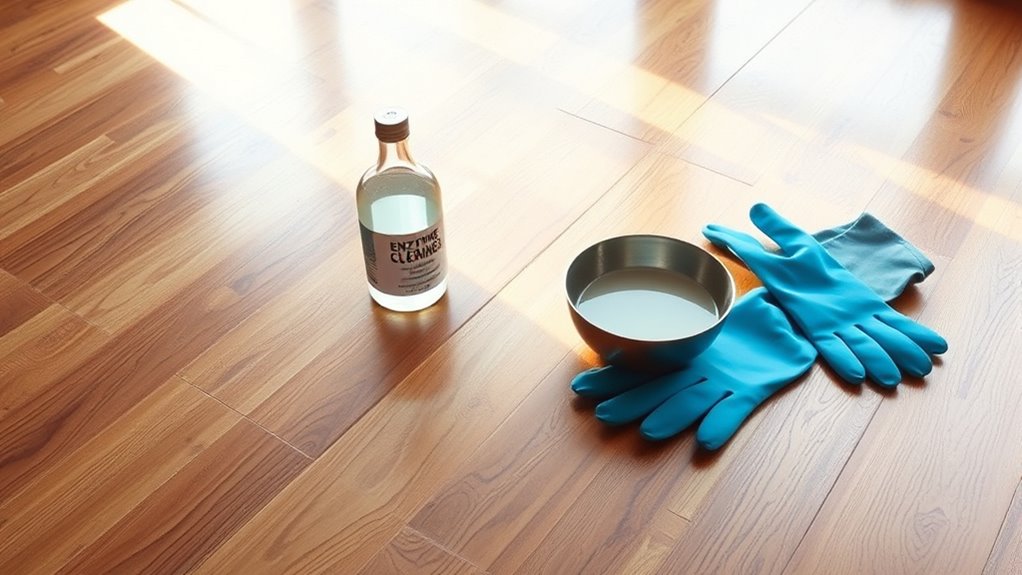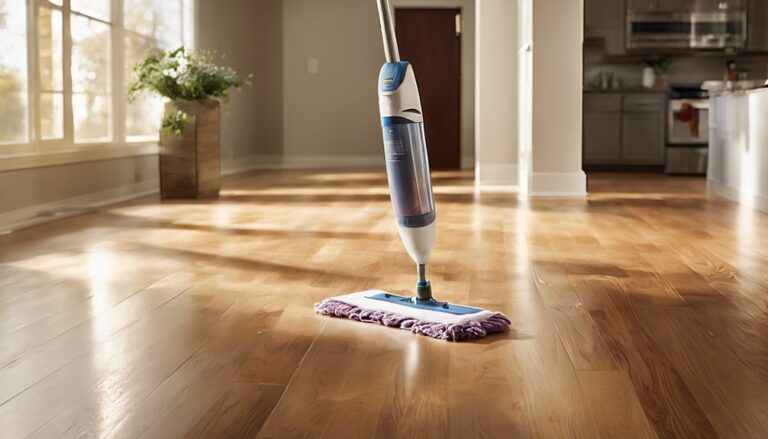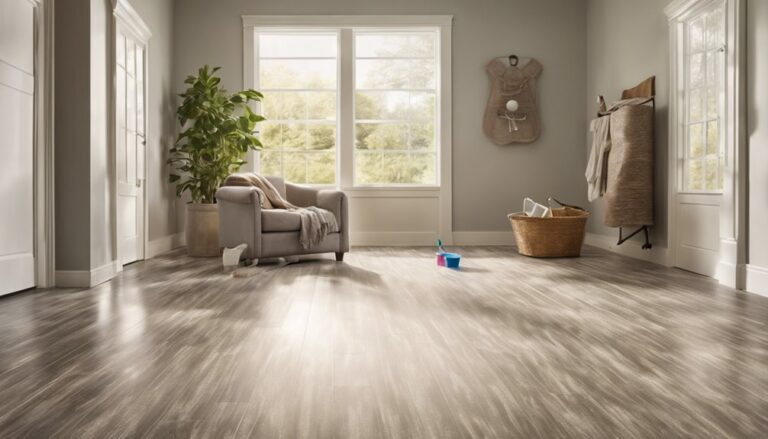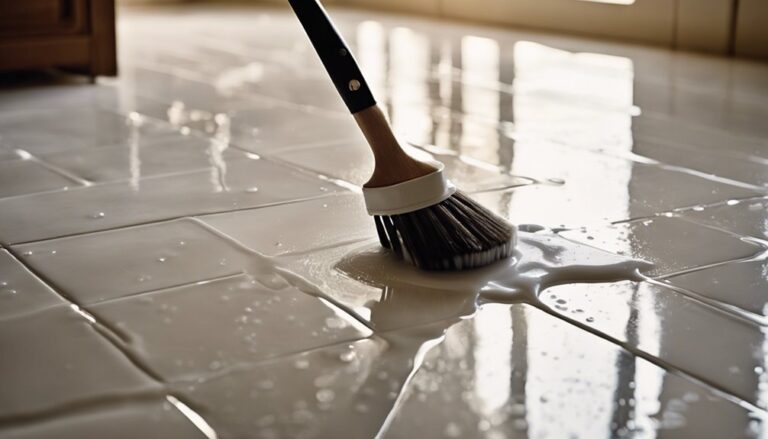If your cat urinates on wood floors, act quickly by blotting the area gently—avoid rubbing to prevent damage. Use an enzymatic cleaner to break down urine proteins and neutralize odors, followed by a vinegar and water solution for extra freshness. Sprinkle baking soda afterward to absorb lingering smells. Protect the wood with a sealant and consider training your cat to prevent repeats. For deeply set stains or persistent odors, professional help might be needed. Discover more effective steps to restore your floors perfectly.
Identifying Cat Urine on Wood Floors
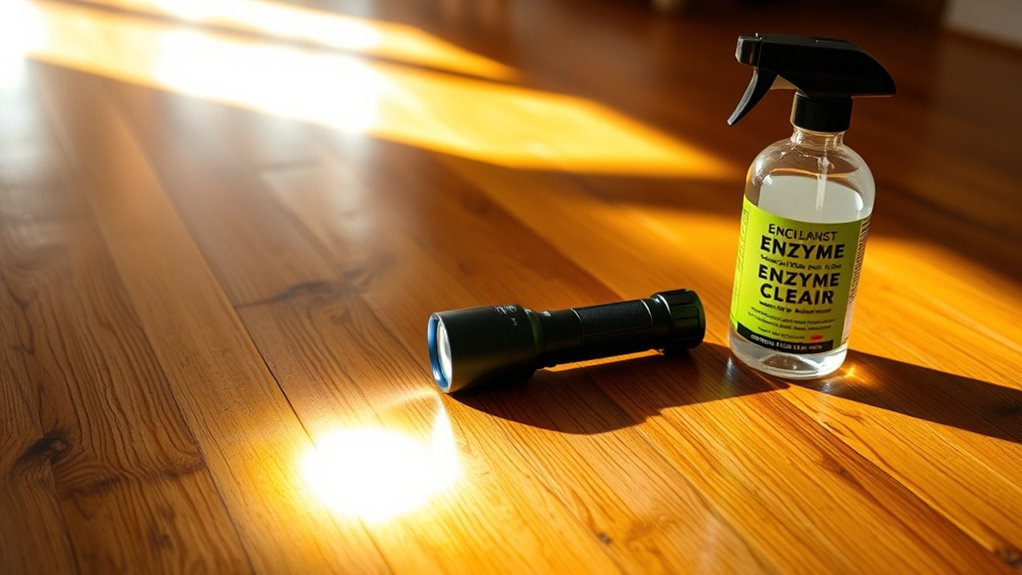
How can you tell if that unpleasant smell on your wood piso is actually cat urine? Recognizing cat urine is essential because it often goes unnoticed, yet it can cause lasting damage if untreated. Pay attention to your cat’s behavior—frequent visits to the same spot, scratching, or sniffing may indicate a problem. For effective urine detection, use a blacklight in a dark room; cat urine fluoresces, revealing hidden stains. Trust your sense of smell too; cat urine has a distinct ammonia-like odor. Identifying these signs early empowers you to act swiftly, preserving your wood floors and maintaining your home’s freedom from persistent odors. Understanding these indicators connects you to your pet’s behavior and helps maintain a harmonious living space.
Immediate Steps to Take After an Accident
Once you’ve identified the presence of cat urine on your wood floors, acting quickly can prevent stains from setting and odors from lingering. First, gently blot the area with paper towels or a clean cloth—don’t rub, as this pushes urine deeper into the wood. Understanding cat behavior helps here: accidents often happen due to stress or litter box issues, so addressing those can reduce repeats. Next, use appropriate cleaning techniques designed for wood floors to remove the urine without damaging the finish. Avoid harsh chemicals that might worsen the stain or odor. Immediate action not only preserves your floor’s integrity but also keeps your living space fresh and inviting. Taking these steps empowers you to maintain a clean, free home despite occasional mishaps.
Essential Cleaning Supplies for Wood Floor Urine Removal
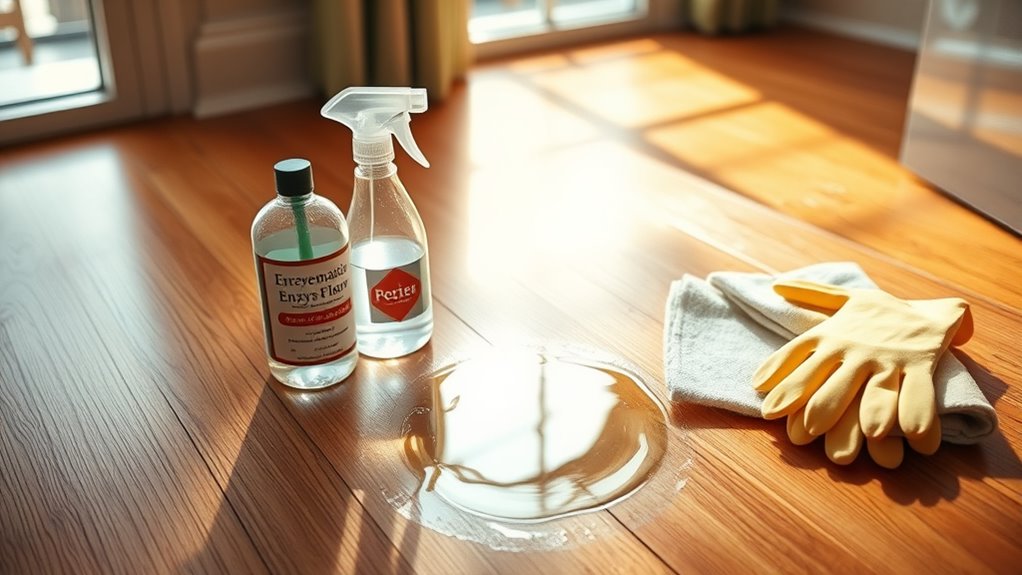
Effective removal of cat urine from wood floors depends largely on having the right cleaning supplies at hand. With the proper tools, you can confidently tackle odor removal and guarantee your floor’s integrity. Here’s a quick guide to essential supplies that support effective cleaning techniques:
| Suministrar | Objetivo | Tips for Use |
|---|---|---|
| Enzymatic Cleaner | Breaks down urine proteins | Use generously for odor removal |
| Paños de microfibra | Absorb moisture & residue | Avoid abrasive materials |
| Vinagre blanco | Neutralizes odors naturally | Dilute with water before use |
| Bicarbonato | Absorbs lingering smells | Sprinkle after cleaning |
| Guantes | Protects your skin | Wear during all cleaning steps |
Having these supplies ready empowers you to restore freshness and freedom to your living space effectively.
How to Safely Clean Cat Urine From Hardwood
When you spot cat urine on your hardwood floors, it’s essential to identify the stain quickly to prevent lasting damage. You’ll want to choose cleaning products that are effective yet gentle enough to protect the wood’s finish. Taking these precautions helps you clean safely while preserving your floors’ beauty.
Identifying Urine Stains
How can you tell if cat urine has soaked into your hardwood floors? First, pay attention to your cat’s behavior—if they’re repeatedly avoiding the litter box or sniffing certain spots, there’s a good chance urine is involved. Urine detection isn’t always obvious; stains might be invisible but can cause lingering odors. To identify affected areas, use a UV blacklight in a dark room—urine stains will glow a yellow-green hue. Check for discoloration or warping on the wood surface, which signals deeper absorption. Promptly recognizing these signs empowers you to act quickly, preventing permanent damage. Understanding your cat’s behavior combined with effective urine detection helps maintain your freedom to enjoy a fresh, clean home without hidden surprises beneath your floors.
Cómo elegir productos de limpieza seguros
Although it might be tempting to grab any cleaner you have on hand, choosing the right products is essential to protect your hardwood floors while eliminating cat urine effectively. You’ll want to prioritize product safety to avoid harsh chemicals that can damage the wood or leave lingering odors. Eco friendly options are a smart choice—they’re gentle on your floors and better for your indoor environment. Look for enzymatic cleaners specifically designed to break down urine molecules without compromising the finish of your hardwood. Always test any product on a small, hidden area first to verify it won’t discolor or harm your floor. By selecting safe, effective cleaners, you free yourself from worry and keep your floors looking great while tackling the issue head-on.
Preventing Wood Damage
Since cat urine can quickly penetrate and damage hardwood floors, it’s essential to act promptly and carefully to prevent lasting harm. You want to protect your floors without sacrificing their natural beauty or your freedom to enjoy your home fully. Here are key preventive measures to keep in mind:
- Immediately blot urine to minimize absorption.
- Use enzymatic cleaners designed for pet stains to break down urine compounds.
- Apply protective coatings like polyurethane to seal the wood and resist future damage.
- Maintain regular cleaning routines to spot issues early and protect your floor’s finish.
Using Enzymatic Cleaners to Eliminate Odors
When it comes to removing cat urine odors from wood floors, enzymatic cleaners are your best ally because they break down the urine molecules at their source. You’ll want to choose products specifically designed for pet stains to guarantee they’re effective and safe for your flooring. Using the right enzymatic cleaner not only eliminates odors but also helps prevent your cat from marking the same spot again.
How Enzymatic Cleaners Work
If you’ve tried traditional cleaning methods without success, enzymatic cleaners offer a powerful solution for eliminating cat urine odors from wood floors. These cleaners use enzymatic action to target and break down the molecules causing the odor, rather than just masking it. Here’s how they work:
- Enzymes in the cleaner identify organic compounds in cat urine.
- They catalyze a chemical reaction that breaks down these compounds.
- This odor breakdown neutralizes the smell at its source.
- The result is a truly clean surface, free of lingering scents.
Choosing Effective Enzymatic Products
Although enzymatic cleaners are highly effective, not all products are created equal, so it’s important you choose one specifically designed for pet urine on wood floors. When evaluating enzyme effectiveness, look for products that break down urine molecules deeply without damaging your flooring finish. Reading product comparisons can help you identify solutions with proven success in neutralizing odors and stains. Avoid cleaners intended solely for carpets or upholstery, as they may lack the right formulation for wood. You want a cleaner that penetrates wood grain and leaves no residue, ensuring complete odor elimination. By selecting the right enzymatic cleaner, you maintain your freedom from lingering smells and protect your wood floors, restoring your home’s fresh, inviting atmosphere.
Natural Remedies for Neutralizing Cat Urine Smell
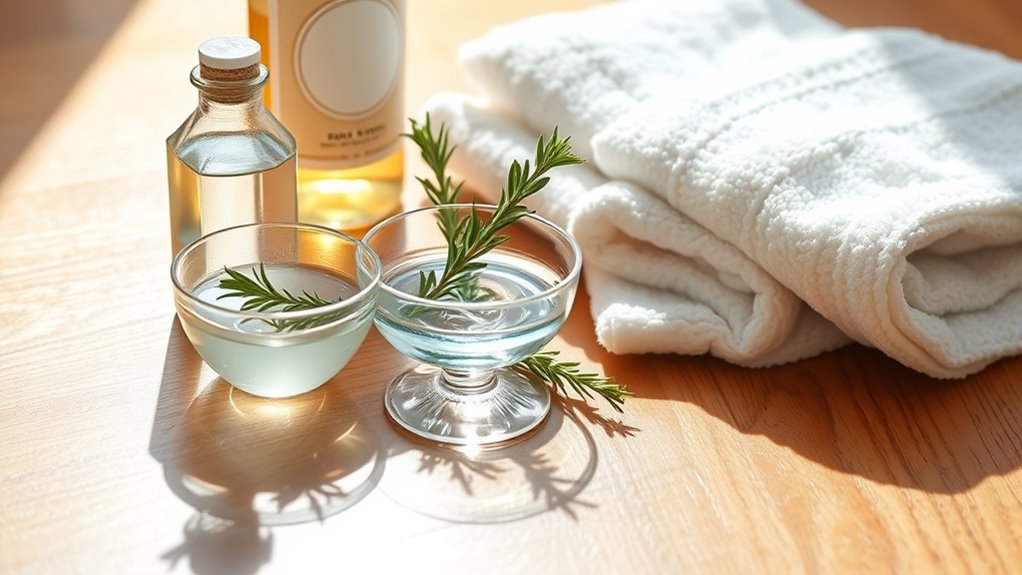
Because cat urine can leave a stubborn odor on wood floors, using natural remedies is a smart and safe way to neutralize the smell without harsh chemicals. You want solutions that work effectively while preserving your freedom from toxic cleaners. Here are four natural remedies to try:
Neutralize cat urine odors on wood floors naturally and safely without harsh chemicals.
- Bicarbonato: Sprinkle it generously over the affected area, let it sit for several hours, then vacuum to absorb odors.
- Vinegar solution: Mix equal parts white vinegar and water, spray lightly, and wipe with a clean cloth to break down odor-causing compounds.
- Hydrogen peroxide: Use a 3% solution on tough smells but test first to avoid discoloration.
- aceites esenciales: Add a few drops of lavender or tea tree oil to your vinegar solution for a fresh scent.
These remedies help you reclaim your space naturally and effectively.
Preventing Stains and Damage on Wood Floors
When you want to keep your wood floors looking their best, taking proactive steps to prevent stains and damage is crucial. Cat urine can deeply penetrate and discolor wood if not addressed quickly, so implementing preventative measures is key. Start by sealing your floors with a high-quality, urine-resistant finish to create a protective barrier. Regularly clean and inspect areas where your cat spends time to catch accidents early. Using waterproof mats or rugs in vulnerable spots adds an extra layer of protection and aids in stain prevention. Remember, prompt cleanup combined with these preventative measures will save you time, money, and the frustration of permanent damage. Taking control now guarantees your wood floors remain beautiful and free from stubborn stains, giving you the freedom to enjoy your home worry-free.
Tips for Training Your Cat to Avoid Flooring Accidents
Protecting your wood floors from cat urine starts with more than just barriers and quick cleanups—it involves helping your cat develop good bathroom habits. You can train your feline friend effectively by focusing on consistency and encouragement. Here are four key tips:
Effective cat training goes beyond cleanup—it’s about building consistent, positive bathroom habits for lasting protection.
- Make certain the litter box is always clean and easily accessible, as cats prefer a tidy spot.
- Place multiple litter boxes in different locations if you have a large home.
- Use positive reinforcement by rewarding your cat with treats or affection when they use the litter box.
- Address any stress or health issues promptly, as these can lead to accidents.
When to Call a Professional for Help
If you’ve tried various cleaning methods and the odor or stain from cat urine still lingers, it might be time to contemplate professional help. Persistent odors can penetrate deeply into wood, making home remedies less effective. Seeking professional services guarantees the problem is addressed thoroughly, protecting your floors and home environment. Experts bring specialized equipment and expert advice tailored to your specific flooring type, which can save you time and frustration. Don’t hesitate to reach out if the stain spreads, the smell intensifies, or if you want to prevent long-term damage. Remember, getting help isn’t a sign of failure—it’s a smart choice to restore your freedom from unpleasant odors and maintain the beauty of your wood floors.
Maintaining Wood Floors After Urine Cleanup
Even after you’ve successfully removed cat urine from your wood floors, ongoing care is essential to keep them looking their best and to prevent future damage. Proper floor maintenance not only preserves the wood’s beauty but also extends its lifespan, giving you the freedom to enjoy your space without worry. To maintain your floors effectively, focus on:
- Conducting regular inspections for any signs of discoloration or odor.
- Cleaning spills immediately with appropriate wood floor cleaners.
- Applying a protective sealant annually to guard against moisture.
- Using rugs or mats in high-traffic or pet-frequented areas to reduce wear.

